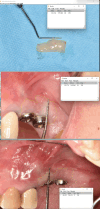Clinical outcomes of free gingival graft vs. palatal pedicle graft in peri-implant soft tissue phenotype modification: A randomized controlled trial comparing patient reports
- PMID: 39758265
- PMCID: PMC11699260
- DOI: 10.34172/japid.2024.016
Clinical outcomes of free gingival graft vs. palatal pedicle graft in peri-implant soft tissue phenotype modification: A randomized controlled trial comparing patient reports
Abstract
Background: The importance of peri-implant soft tissues in maintaining tissue health and aesthetics has been recognized. A thickness of at least 2 mm is considered a protective factor against peri-implantitis. This study assessed clinical outcomes and complications at implant sites following soft tissue augmentation with either palatal free gingival graft (FGG) or palatal pedicle graft (PPG).
Methods: In this randomized controlled clinical trial, 42 patients with inadequate keratinized tissue width (KTW) were randomly assigned to two intervention groups: Group 1 received FGGs, while group 2 underwent PPGs. The KTW, vestibular depth, and surface shrinkage were recorded preoperatively and one and three months after the operation. Patient-reported outcome measurements were recorded at a two-week follow-up.
Results: Thirty-five patients completed the study (FGG group, n=17; PPG group, n=18). Group 2 demonstrated a higher increase in KTW and vestibular depth at 1 and 3 months (P<0.05). The surface shrinkage differences were not statistically significant between the study groups at baseline and three-month follow-up (P>0.05). The number of analgesics in each group was not significantly different two weeks after the operation; however, the Numeric Pain Rating Scale (NPRS) showed significantly higher pain scores on days 3 to 8 in group 1 patients.
Conclusion: The use of PPG in soft tissue augmentation demonstrated more KTW formation and less postoperative morbidity. There was no difference between the methods used to compare surface shrinkage.
Keywords: Dental implants; Free gingival graft; Keratinized tissue width; Palatal pedicle graft; Surface shrinkage.
© 2024 The Author(s).
Conflict of interest statement
The authors declare no competing interests.
References
-
- Behneke A, Behneke N, d’Hoedt B. A 5-year longitudinal study of the clinical effectiveness of ITI solid-screw implants in the treatment of mandibular edentulism. Int J Oral Maxillofac Implants. 2002;17(6):799–810. - PubMed
-
- Karoussis IK, Salvi GE, Heitz-Mayfield LJ, Brägger U, Hämmerle CH, Lang NP. Long-term implant prognosis in patients with and without a history of chronic periodontitis: a 10-year prospective cohort study of the ITI Dental Implant System. Clin Oral Implants Res. 2003;14(3):329–39. doi: 10.1034/j.1600-0501.000.00934.x. - DOI - PubMed
LinkOut - more resources
Full Text Sources
Miscellaneous




